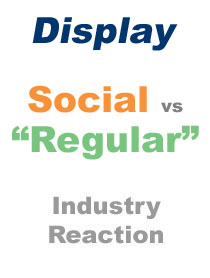 In spite of recent announcements that Facebook has surpassed Google and Yahoo! for overall display impressions, ecosystem feedback suggests there’s a difference between what a Facebook or social display impression (Twitter, StumbleUpon, etc.) offers and that of a “regular” display impression – i.e. through a standard IAB-sized display ad unit.
In spite of recent announcements that Facebook has surpassed Google and Yahoo! for overall display impressions, ecosystem feedback suggests there’s a difference between what a Facebook or social display impression (Twitter, StumbleUpon, etc.) offers and that of a “regular” display impression – i.e. through a standard IAB-sized display ad unit.
With this challenge in mind, AdExchanger.com asked a range of representatives on the social side of the digital ad ecosystem the following question:
“What is the difference between a social display impression and a ‘regular’ display impression?”
Click below or scroll down for more:
- Florian Kahlert, SVP of KN Dimestore
- Justin Merickel, VP of Marketing, Efficient Frontier
- Aaron Goldman, CMO, Kenshoo
- Gurbaksh Chahal, CEO, RadiumOne
- Rob Leathern, CEO, XA.net
- Dave Williams, CEO, BLiNQ Media
Florian Kahlert, SVP of KN Dimestore, a subsidiary of Knowledge Networks
“A social ad impression is quite different from a ‘regular’ ad impression. On Facebook, for example, the brand message is embedded in the conversation rather than distinct from it, and the actual display ad is just part of the overall advertising message. The most valuable part of Facebook is the peer recommendation and the earned media portion. Advertisers clearly see value in this embedded model as an advertising medium, but they should keep two points in mind: One is that Facebook performance involves costs outside the media budget — costs to build and maintain fan pages, costs to give fans incentives to interact. The second point is that social campaigns won’t work for every brand. For some products, this pervasive model boosts overall effectiveness: People like getting recommendations from trendsetters and trusted sources. However, many advertisers offer products that people want and need, but are not comfortable recommending in public — medications and personal hygiene products come to mind — or simply don’t find interesting to recommend. Some of these products have huge budgets. The other display behemoths have a huge opportunity to cater to those clients with enticing user experiences.
Justin Merickel, VP of Marketing, Efficient Frontier
“A social impression is one that includes the explicit social endorsement of a friend or connection. The simplest form of social endorsement is the “like” or “plus” action on Facebook or Google. These are easy consumer actions that are powerful additions to ads. Facebook’s Sponsored Stories represent a more complex social endorsement, using direct interactions with brands as the content of the ad itself. Our research has shown that Sponsored Stories generate over 3X higher CTR as compared to other ads on Facebook at a consistently lower cost-per-action.
The success of socially endorsed ads will yield increasing emphasis on this ad-type across the industry. With Google, Twitter, and others holding robust data assets on likes, interests, and connections, we are likely only seeing the beginning of how these ads will be executed over the coming months and years. More traditional online publishers lacking this social data will be forced to innovate themselves or partner to benefit from growing demand for social impressions.
In order to capitalize on the opportunity, smart marketers are linking content with ads much more closely. New organizational and process alignment is already starting to happen. Achieving both a critical mass of fans/followers and delivering strong engagement on and off social networks is required to deliver on the potential impact of social impressions.”
Aaron Goldman, CMO, Kenshoo
“A ‘social’ display impression is any display impression that has social context.
Here are 4 examples [of a social impression]:
- An ad delivered within a social network.
- An ad delivered anywhere on the web embedded with social signals such as likes, retweets, or +1s.
- An ad delivered anywhere on the web with embedded social content such as full posts from Facebook or Twitter related to the brand being promoted.
- An ad delivered anywhere on the web targeted to an individual (or individual IP address) based on the social media activity/connections of that person (or IP address).
A ‘regular’ display impression is simply an ad that doesn’t meet any of these criteria.”
Gurbaksh Chahal, CEO, RadiumOne
“Facebook surpassed Yahoo in display ad spending because of three factors. First, they have a massive and highly engaged audience. Second, the time users spend on Facebook generates 1/3 of all page views of all web traffic. Lastly, the new social ad-unit that enabled “liking” pages and things and that action subsequently was broadcast into your social graph. The last point was the tipping point because it created differentiation and disruption in the display world. Display adverting was no longer created equal. Yahoo, like the vast majority of Internet publishers sells traditional display advertising (e.g. search and banner ads). Facebook got and continues to get a lot of ad-dollars because of their socially enabled display ad units, however, the long-term sustainability [display ad revenue] will depend on whether the ad-units generate ROI.
The marriage of both audience buying and the power of a social graph is the way of the future. By incorporating social elements into an existing display strategy, drives engagement and almost guarantees a positive result. That’s where I agree with Google that display advertising does have the opportunity to become a $200 billion industry. Impressions without any social call-to-action aka “regular” impressions have to work a lot harder then socially enabled impressions. The days for display ads without any social element are numbered.”
Rob Leathern, CEO, XA.net
“With Twitter and LinkedIn’s ad products still experimental and early, respectively, social display remains a one-horse race today and that horse is Facebook. Facebook’s display impressions are at their worst, easy to compare to one another due to a more-homogenous set of places they show up than the myriad of possible placements in traditional display (where there is a lack of clear guidelines and standards on placement, how many ads per page etc.). At their best, though, Facebook impressions have the most reliable demographic and geographic targeting available anywhere today, and the beginnings of a powerful interest/affinity-based targeting schema that is starting to show dividends for many smart marketers. Their sponsored stories also herald a new form of ‘critical-mass’ marketing where audience subgroup popularity (target ads so that I see several friends are interested in a new product, thus compelling my interest) may trump simultaneous mass reach (ads without social context).”
Dave Williams, CEO, BLiNQ Media
“A social display impression is targeted based on first-party data, can be targeted based on the social graph (i.e., can target friends) and can be initiated by a consumer through a “Sponsored Stories” ad unit, aka a “consumer-initiative ad.” Moreover, the purpose of a social display ad is to drive engagement, whereas most regular non-social impressions aim to drive clicks and ROI. (Non-social impressions that use a rich media ad unit are different, of course — many seek to build engagement.) Social ad impressions may include a friend’s social endorsement of the brand, which boosts relevance and performance. The targeting of a social display impression can thus be more precise, whereas regular display impressions either are based on behavioral data, are targeted contextually, or rely on general site demographics. Those cases raise the potential both for overlap and for ads appearing on undesirable third-tier sites. Finally, given the large percentage of people that log in to social networks each day for extended periods of time, social impressions have a greater ability to reach a desired audience at a desired frequency. In that way, social display impressions resemble TV metrics more closely than regular display impressions.”
By John Ebbert
More AdExchanger “Industry Reactions”…
- Can It Be Done? Local, Direct, Automated Ads
- The Impact Of No More Third-Party Cookie Targeting In Firefox
- House Ads – What Are They Good For?
- What is "Premium"?
- When Is A Startup No Longer A Startup?
- Why Is Procurement Necessary?
- Agency CEOs: 2013 Planning Is About Mobile Integration
- Can You Build a Brand in Programmatic Media?
- How Do Native Advertising and Real-Time Bidding Meet?
- Why Target The Tablet?
- The Publisher Impact Of Facebook Exchange And Ad Network
- Agencies Upbeat on Tying Facebook to Cross-Channel Ads
- Are Advertisers Living the Dream of Unified Marketing and IT?
- What Next For Yahoo?
- What Counts as 'Scale' in Hyperlocal? Mobile Ad Players Weigh In
- Facebook Buys Instagram – What’s In It For Ads?
- Are Ad Servers Specifically For Publishers Or Advertisers Still Necessary?
- How Will The iPad 3 Impact Audience Buying Available Through The iPad?
- Will The Merger Of DDS And MediaBank Into Mediaocean Benefit Media Buying?
- Will SSPs and Ad Networks Sell Publisher Inventory Through DoubleClick Ad Exchange?
- The Industry 'Take' On SAS Acquiring aiMatch
- Industry Impressions Of Facebook Display Advertising
- What Are The Hurdles In Cross-Digital, Audience Buying?
- When Is A Mobile, Private Exchange Relevant To A Marketer's Needs?
- Your Ad Server, My Ad Server: Trends With Discrepancies Today
- The Opportunities Ahead For New Yahoo! CEO Scott Thompson – Industry Reaction
- Predictions 2012
- Industry Reaction: Adobe Acquires Efficient Frontier
- Yahoo! Requiring RMX Seats For DSP Advertisers
- Yahoo!, Aol And Microsoft Pool Their Premium, Non-Guaranteed Display Inventory
- Whats The Biggest Challenge With Platform Buying In Digital Today?
- Industry Reaction: Yahoo! Acquires interclick For $270 Million
- How Important Is -First Look- At Inventory?
- Where Does The Tablet Fit In The Marketer Media Plan?
- MediaBank-DDS Merger Industry Reaction: Questions Remain About MediaOcean
- Is An Online GRP Needed For Online Video Advertising?
- What Should Yahoo Do Next?
- What Solutions Are Still Needed For The Premium, Digital Publisher of Today?
- How Do Search Marketers Overcome The Creative Challenge In Graphical, Display Advertising?
- What Is The Difference Between A Social Display Impression And A Regular Display Impression?
- Is Audience Buying Possible In Mobile Advertising?
- What Are The Key Metrics For Brand Awareness Campaigns In An Automated Buying Environment?
- What Is The Biggest Challenge With The Demand-Side Platform Model?














